When it comes to landscaping your outdoor space, there’s an array of creative ideas to choose from. One unique and eco-friendly approach gaining popularity is tree ring landscaping. Tree ring landscaping, also known as tree ring gardens, not only adds aesthetic appeal to your garden but also promotes the health and longevity of your trees. In this blog, we’ll dive into the world of tree ring landscape ideas and discover how they can transform your outdoor space. From practical benefits to design inspirations, we’ll cover it all.
1. The Benefits of Tree Ring Landscaping
1.1 Protecting Your Trees
Tree rings act as a natural buffer zone around your trees. They protect the roots from soil compaction, lawnmower damage, and weed competition. This promotes healthy tree growth and can extend the life of your trees.
1.2 Enhanced Aesthetics
One of the key advantages of tree rings is the visual appeal they bring to your landscape. They create defined spaces and can be designed to complement your overall garden theme. Whether you prefer a formal or a more relaxed look, tree rings can adapt to your style.
1.3 Reduced Maintenance
Tree ring gardens can significantly reduce the amount of lawn to mow and maintain. This not only saves you time but also conserves water and lowers your landscaping costs.
2. Choosing the Right Trees for Your Tree Rings
2.1 Native Trees
Selecting native trees for your tree rings is a wise choice. Native trees are adapted to your region’s climate and soil conditions, making them more likely to thrive. Additionally, they support local wildlife and require less maintenance.
2.2 Tree Size and Shape
Consider the size and shape of the tree when planning your tree ring. Smaller trees with a single trunk work well with circular rings, while larger, multi-trunk trees may benefit from oval or irregularly shaped rings.
2.3 Tree Compatibility
Ensure that the trees you choose for your tree rings are compatible in terms of sunlight and water requirements. Mixing trees with similar needs will result in a healthier and more attractive landscape.
3. Designing Your Tree Ring Landscape
3.1 Creating Layers
Add visual interest to your tree rings by incorporating layers of plants. Plant taller species towards the outer edge and gradually decrease the height towards the tree trunk. This mimics natural forest understories and provides a habitat for various wildlife.
3.2 Mulch and Groundcover
Mulch is a tree ring’s best friend. Apply a layer of mulch around your trees to retain moisture, suppress weeds, and regulate soil temperature. Groundcover plants like creeping thyme or vinca can be interspersed for added texture and color.
3.3 Decorative Elements
Don’t be afraid to get creative with decorative elements within your tree rings. Consider adding a stone border, decorative rocks, or even small sculptures to personalize your landscape.
4. Maintenance Tips for Tree Ring Gardens
4.1 Watering and Irrigation
Proper watering is essential for tree ring gardens. Water deeply and consistently, especially during the tree’s establishment phase. Consider using drip irrigation to ensure even moisture distribution.
4.2 Pruning and Trimming
Regular pruning and trimming of branches and groundcover plants help maintain the shape and health of your tree ring. Be cautious not to damage the tree’s bark during this process.
4.3 Weed Control
Weeds can quickly invade tree rings if left unchecked. Apply a weed barrier fabric beneath the mulch and regularly inspect and remove any weeds that may emerge.
5. Inspiring Tree Ring Landscape Ideas
5.1 Flowering Tree Rings
Enhance the beauty of your outdoor space with flowering tree rings. Plant vibrant perennials and annuals that bloom at different times of the year to ensure year-round color.
5.2 Herb and Vegetable Tree Rings
Combine beauty with functionality by creating herb and vegetable tree rings. Grow culinary herbs like basil and rosemary or plant vegetables like lettuce and tomatoes within your tree rings.
5.3 Butterfly and Pollinator-Friendly Tree Rings
Attract pollinators like butterflies and bees by including nectar-rich flowers such as lavender, coneflowers, and milkweed in your tree rings. This not only adds beauty but also supports local ecosystems.
5.4 Zen Garden Tree Rings
For a tranquil and minimalist look, consider creating Zen garden-inspired tree rings. Use smooth river rocks, fine gravel, and carefully placed stones to evoke a sense of calm and serenity around your trees.
6. FAQs
Q1: Can I use any type of mulch for my tree rings?
A1: While there are various mulch options available, organic mulches like wood chips or bark are excellent choices as they break down over time, adding nutrients to the soil.
Q2: How often should I water my tree ring garden?
A2: The frequency of watering depends on factors like climate and soil type. Generally, a deep watering every 1-2 weeks is sufficient, but adjust based on your specific conditions.
Q3: Can I create a tree ring around an existing tree?
A3: Yes, you can retrofit a tree ring around an existing tree. Just be cautious not to damage the tree’s roots during installation.
Conclusion
Tree ring landscaping is a versatile and practical way to enhance your outdoor space. By protecting your trees, reducing maintenance, and adding visual appeal, tree rings offer numerous benefits. Whether you opt for a flowering, edible, or Zen-inspired design, tree ring gardens can transform your landscape into a natural haven. So, roll up your sleeves, choose the right trees, and let your creativity bloom in your own tree ring paradise.





